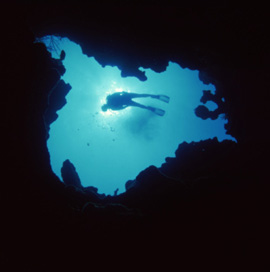Introduction to Cave Diving
Posted: Jun 05 in Dive Blog tagged Specialty Diving by Jan Because Illinois divers don’t have the benefit of the open ocean, we need to find more creative locations to satisfy our SCUBA needs.
Because Illinois divers don’t have the benefit of the open ocean, we need to find more creative locations to satisfy our SCUBA needs.
For those adventurous divers trained and certified in cave diving, exploring underwater caves offers some of our planet’s richest and unusual environments. For a chance to see truly unique geological features and wildlife that can’t be found anywhere else it doesn’t get much better than cave diving. However, cave diving also presents a number of dangers that regular open water dives do not, making dive classes and proper dive certification mandatory before plumbing the depths of nature’s underground waterways.
Interested in diving into some cave exploration? Classes are a necessity, but once you are trained these five rules provide a good basis for staying safe during any cave dive:
Keep a continuous guideline to the surface.
What’s worse than running low on air in an underwater cave? Running low on air without knowing your way out. Though you may be picturing a wide-open underwater cavern or a large and uncomplicated tunnel, many caves are maze-like and can be very confusing for divers. To make matters worse, many divers who aren’t trained in precise buoyancy control or proper cave propulsion techniques can leave a silt trail behind them that reduces visibility and makes it more difficult to find the correct way back. This makes running a continuous guideline from the cave entrance absolutely crucial, as this will give you an infallible line towards safety.
Reserve a minimum of two-thirds of your starting gas for your exit.
In overhead environments where surfacing in the event of an emergency is not an option, conservative gas management is critical. Cave and technical divers utilize what is known as the Rule of Thirds, where the first third of your gas supply is used for your trip into the overhead environment, another third for your trip out of the overhead environment and the last third as an emergency reserve. Many Cave and technical divers are even more conservative, subtracting out a portion of their gas supply (known as “Rock Bottom” or “Minimum Air Reserve”) from their starting pressure as an emergency reserve and then applying the Rule of Thirds to their remaining gas supply. The goal of course is to ensure that you and your team mates have enough gas to make it out safely if anything goes wrong.
Don’t go too deep.
Exceeding a depth of 130 feet creates a real risk of nitrogen narcosis, and depending on depth, oxygen toxicity, either of which can be a recipe for disaster on open water dives let alone dives in an overhead environment. Though highly-trained professionals with the proper equipment and breathing gas mixtures do explore cave waters as deep as 300 feet, recreational cave divers do not. If you don’t stay within the limits of what your diver training and breathing gas can handle you may not make it back to the surface.
Bring plenty of lights.
Caves are dark and diving lights can be unreliable. If your light fails and you don’t have a backup you’ll be left helpless in your chosen cave’s pitch blackness and it will be difficult to find your guideline for a safe exit. Cave divers carry three battery-powered dive lights with them at all times—one primary and two backups to ensure their continued safety.
Don’t exceed the limits of your training.
The vast majority of diving accidents result from people being ill-equipped, underprepared or uneducated about the realities of diving. Technical diving, as in caves, requires specialized equipment and tactics to ensure proper safety in an overhead environment. As such, you should never go beyond your training or what you feel comfortable with. Even if you’re a seasoned, well-trained cave diver, pushing yourself to do something beyond your limits during a cave dive is certain to spell disaster.
With the right precautions and advanced training, cave diving, or its little brother, cavern diving, can be great great adventure for any technical diving enthusiast. For those who think they may be interested, Do Dive In’s Intro to Technical Diving course is a terrific introduction to the tools and techniques required for technical and Cave diving (plus, it will improve your open water skills).
Have you been cavern or cave diving before? Tell us about it in the comments below.
